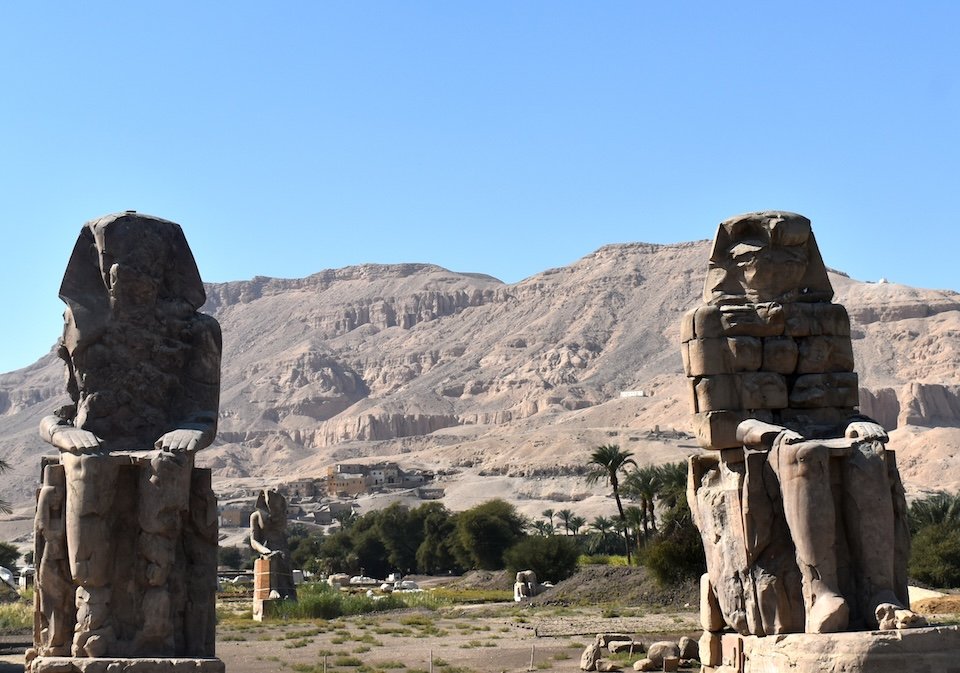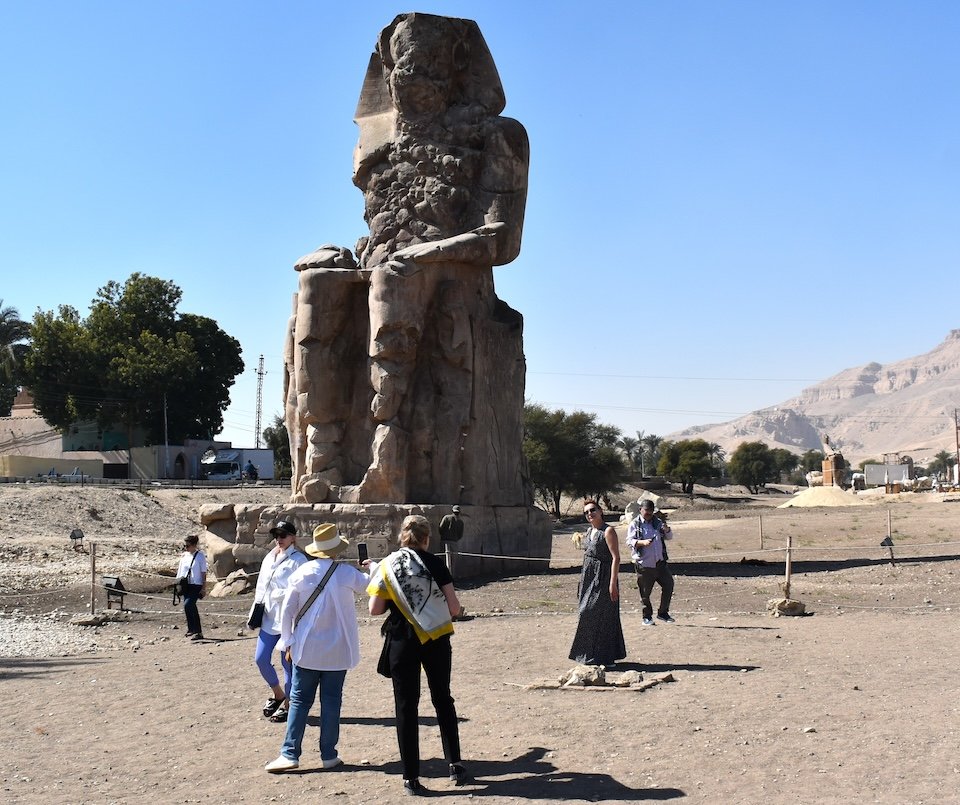A Nile cruise in Egypt is a great way for travelers to see some of the most famous locations from ancient history. The Memnon statues, also known as the Colossi of Memnon, are one of the most amazing things you should see on your trip. These tall statues watch over the countryside and invite you to learn more about the interesting stories of the past. As you sail over the beautiful waters of the Nile, get ready to see Luxor’s most famous sights, which will leave you in awe at the greatness of ancient Egyptian culture. Join us as we explore the amazing Memnon sculptures and the treasures that await you on your memorable journey down the Nile.

On your way to the Valley of the Kings on Luxor’s West Bank, you can’t miss the Colossi of Memnon, two giant statues that have stood for millennia.
They once guarded the entrance to the memorial temple of Pharaoh Amenhotep III. While the temple behind them is now gone, the impressive statues remain.
The ancient Egyptians lived on the East Bank (the land of the living), where the sun rises, and buried their dead on the West Bank (the land of the dead), where the sun sets, following the daily cycle of the sun god.
The Colossi of Memnon stand majestically on the West Bank of the Nile in Luxor, representing one of the city’s most iconic archaeological landmarks. Originally, these massive statues guarded the entrance to the grand mortuary temple of Pharaoh Amenhotep III. He was a powerful ruler of the 18th Dynasty during the New Kingdom, an era that marked the zenith of ancient Egypt’s imperial power and artistic glory.
No trip to Egypt, and especially Luxor, is complete without witnessing these ancient sentinels. A visit to the Colossi of Memnon is a guaranteed highlight of our Nile cruise itineraries, giving you the perfect opportunity to experience their grandeur firsthand.
The History and Disappearance of Luxor’s Largest Temple.
The Temple of Amenhotep III was the largest and most monumental funerary temple built in Luxor. It is perhaps the largest funerary temple in all of ancient Egyptian civilization. However, it was subjected to a number of factors that almost destroyed it, reducing it to ruins. This included a massive earthquake that occurred during the Pharaonic era, as proven by a number of modern scientific studies and research. The temple has also been used as a quarry to steal its stones, statues, and floors since the reign of the Ramesside kings. Its stones have been reused in a number of temples since the Pharaonic era, and this practice has continued even in modern times, as the temple has suffered extensive damage throughout the ages.
The majority of the temple, approximately two-thirds of it, currently lies under agricultural land, some of the homes of residents, and the private properties surrounding the temple.

Description of the Colossi of Memnon.
The two statues of Memnon represent King Amenhotep III, seated on a throne with his hands on his knees and atop his head, wearing the double crown over the ancient Egyptian headdress called the Nemes. He also wears a short kilt, the shendit. Standing on either side of the throne, at the king’s feet, are his mother, Mutemwiya, a Mitanni woman from Iraq, and on the other side is his wife, Queen Tiye, who is also standing.
Each statue is approximately 21 meters tall (currently about 19.5 meters) and weighs approximately 800 tons. Each statue was cut from a single block of red quartz from the Red Mountain, northeast of Cairo. These massive blocks of red quartz were brought and cut from the Red Mountain in Cairo and placed on ships and sailed upstream on the Nile for a distance of approximately 700 kilometers. This is one of the most astonishing miracles of ancient Egypt.
The Origin of the Name “Colossi of Memnon”.
As for the nickname of the Colossi of Memnon, the name only of the northern statue, not both statues, goes back to an earthquake that occurred in 27 BC, which caused some of the stones of the northern statue to fall and crack. This caused the air to make a whistling sound when it passed through these cracks, which led Greek visitors to liken the statue and associate it with the legendary Ethiopian hero Agatha Memnon, who was killed by Achilles, the legendary Greek hero, in the famous Trojan War. This legend tells that the goddess of dawn, Aurora, or Eos, asked the god Zeus, the greatest of the Greek gods, to distinguish her son from the rest of humanity with something special. He appeared to her at dawn in the form of this voice, and his mother wept for him, her tears like drops of dew. Thieves who plundered the finds of the Pharaonic tombs were afraid of them when they passed by. This sound stopped after the restoration of the northern statue by the Roman Emperor Septimius Severus around 200 AD, so the sound disappeared, and the legend remained.
Colossi of Memnon: What You Need to Know;
What are the Colossi of Memnon?
They are two massive 21m (68ft) stone statues of Pharaoh Amenhotep III. They once stood as guards to his mortuary temple, which is now in ruins.
Is a visit included in my Nile cruise?
Yes, it is a standard photo stop on all Nile cruise tours to Luxor’s West Bank.
How much time will we spend there?
The stop is brief, typically 15-20 minutes, which is enough time for photos and a short explanation from your guide.
Is there an entrance fee for the Memnon Statues?
No, the site is an open-air monument and is completely free to visit.
What should I wear and bring in the summer?
For a visit in the summer, the essentials are:
Sun Protection: Hat, sunglasses, and high-SPF sunscreen.
Clothing: Lightweight, breathable fabrics.
Essentials: Water and a camera.
I heard the statues of Memnon used to “sing.” Is that true?
Yes. After an earthquake in 27 BC, the northern statue would make a sound at dawn, likely from dew evaporating from a crack. A Roman emperor repaired the statue in 199 AD, and it has been silent ever since.
Will there be souvenir sellers at the site?
Yes, expect numerous vendors. A polite “La, shukran” (No, thank you) is effective if you aren’t interested in buying anything.
How close can I get to the statues?
You can walk right up to the base of the statues. You may also see ongoing archaeological work behind them to excavate the original temple.
Trusted Partners
Nile Cruisen: Chosen by Leading Brands as Egypt's Top Cruise Operator











